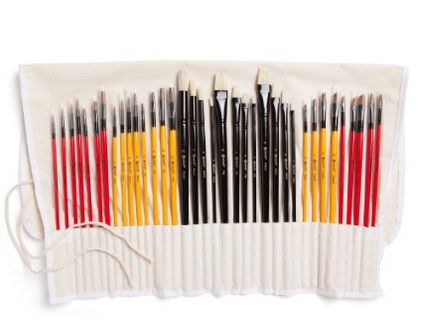Paintbrushes
There exists a dizzying array of brushes to pick from and incredibly it’s a a few preference concerning which ones to buy. Synthetic brushes are better for acrylic paints and Cryla brushes are good quality. Again, better to buy a few top quality brushes compared to a whole load of cheap ones that shed most of their bristles onto the canvas. That being said a series of fairly cheap hog hair brushes are ideal for applying texture paste and scumbling.

The most important principle when using acrylics is not allowing the paint to dry on your brushes. Once dry these are solid and although soaking them in methylated spirit overnight softens them a little, they usually lose their shape and you turn out chucking them out.
It is suggested that portrait artists buy a water container that allows the artist to rest the brushes on a ledge and so the bristles are submerged in water devoid of the bristles being squashed. The artist then needs a rag or perhaps a part of kitchen towel handy to take away any excess water once i next require to use that brush again. This saves needing to thoroughly rinse each brush after each use.
Brush techniques
Brushes need to be damp however, not wet if you utilize the paint quite thickly for the reason that paint’s own consistency will have enough flow. However if you might be attempting to utilize a watercolour technique your paint ought to be combined with a lot of water.
Work with a lpaint supplies and for more detailed work make use of a thinner brush using a point. Support the brush closer to the bristles for increased accuracy or out-of-the-way if you need more freedom with the stroke. Start your portraits by holding a big brush halfway approximately quickly supply the background a color. Artists really should not be so concerned with mixing the complete colour because they can often mix colours about the canvas by moving my brush around in lots of different directions.
One way for family portrait artists is always to start the facial skin using Payne’s Gray to fill in the shadows before using a reasonably opaque background of flesh tint in the event the shadows have dried. Next develop the skin tone with lots of different coloured washes and glazes.
Two different ways might be explored here through the portrait artist:
• Combine a big amounts of the colour about the palette with numerous water and use it liberally on the canvas in sweeping movements to make a standard tint.
• Or ‘scumbling’, that is where your brush is relatively dry, loaded merely a quarter full and dragged across the surface in all of the different directions allowing the dry under painting to exhibit through.
Symbol artists utilize scrumbling technique a whole lot specially when painting highlights and places where light hits your skin like for the tip with the nose, top lip, forehead and cheeks. The scrubbing motion will wreck fine brushes so just use hog hair brushes just for this.
The majority of the family portrait is created up using glazes coming from all different colours. The portrait’s appearance can alter quite dramatically at different stages leaving subjects looking seasick, jaundiced, embarrassed or like they’ve seen a ghost coupled with lots of heavy nights out.
Try to find subtle shades, like there’s often yellow and blue in the skin color under the eyes, pink on the cheeks and within the nose, crimson red on lips and ears and greens and purples within the shadows about the neck and forehead.
Finally, use fine brushes for adding details like eyelashes. It may help if the rest your little finger on the canvas to steady your hand only at that fine detail stage. At the end of pretty much everything you may hopefully have a face seems lifelike and resembles the person or family you are hoping to capture on canvas!
More details about paint brush set have a look at this useful web portal: look at here now
